'Everybody's looking for TV sets': The oral history of the formation of the Big 12 Conference

On Aug. 31, 1996, Kansas State defeated Texas Tech, 21–14, in the first football game in Big 12 history. It was just the fourth time the two programs had faced each other—and a major victory for the former Big Eight and the former Southwest Conference, two decades-old leagues that had dissolved and spurned longtime members for the sake of survival.
Comprising four former SWC schools—Baylor, Texas, Texas A&M and Texas Tech—and the entire former Big Eight—Colorado, Iowa State, Kansas, Kansas State, Missouri, Nebraska, Oklahoma and Oklahoma State—the Big 12 at its inception was a powerhouse. It boasted the 1996 Associated Press preseason No. 1 team (Nebraska) and four teams that finished the year among the AP top 25. And though Nebraska failed to win it all that season, dropping to No. 6 in the final poll, in the 20 years and 960 conference football games since the conference formed, Big 12 football teams have won three national titles.
Since 2010, though, the conference has been fluid, losing Nebraska to the Big Ten, Colorado to the Pac-12 and Missouri and Texas A&M to the Southeastern Conference. As the first league to form with television revenue as its guiding principle, the process the Big 12 set in motion has threatened to undo it multiple times.
Before the 2016 season, talk of Big 12 expansion began again, the first serious conversation since West Virginia and former SWC member TCU joined the conference in October 2011. Commissioner Bob Bowlsby began to vet potential expansion candidates this summer, and on Aug. 12, ESPN reported that the Big 12 would interview at least 18 schools. There's still no precise timetable—although if there's one lesson to be taken from 20 years ago, it's that, with the proper spark, the business of realignment can move almost instantaneously.
Two decades ago, that spark was Texas. The Big 12 is a behemoth of a league, but from day one it's existed by the mercy and on the back of one school. "Texas is the pretty girl that everybody wanted to date," former University of Texas president and chancellor Bill Cunningham says, and as the college football landscape shifted in the late 1980s, the pretty girl began to flirt.
Texas's eye started to wander in the years after the Supreme Court's 1984 ruling that universities, not the NCAA, own their sports' television rights. In the wake of that decision, the College Football Association, a lobbying group formed to protect the interests of its 63 major-program members, negotiated television contracts; in 1990, the CFA was in the midst of a five-year, $210 million deal with ABC. That's when Notre Dame pulled out and negotiated its own deal with NBC, a move that made some administrators wonder if the CFA had become superfluous—and if television might be the builder and breaker of alliances.
Bill Cunningham, former University of Texas president and chancellor: That began the movement, of questioning what we should do.
ABC Sports, in a statement in February 1990: At this point, ABC Sports intends to pursue all remedies available to protect its agreement with the C.F.A. from interference by third parties.
Dick Ebersol, president of NBC Sports from 1989–98, in The New York Times in February 1990: We did not contact Notre Dame. We will not contact other schools about football. We're going to sit back and examine our options over the next several weeks.
R.C. Slocum, Texas A&M coach from 1989–2002: The next thing that happened was the conferences started saying, what if we as a conference pooled our TV rights and marketed them as a whole? Once they did that, college athletics changed dramatically forever. That was kind of the death knell, to me, of the Southwest Conference because you had a league where all the schools were in one state with the exception of Arkansas. If you're looking and thinking in terms of a national television market, it doesn't make sense.
By 1990, Arkansas had announced it would leave for the SEC beginning in 1991, making the SWC a Texas-only conference.
Jon Wefald, Kansas State president from 1986–2009: So here's Arkansas, and then there's Florida State joining the ACC, and then of course another shock is [Big Ten commissioner] Jim Delany getting Penn State to give up their independent status, that esteemed position, and join the Big Ten.
Jim Walden, Iowa State coach from 1987–94: At that time, hell, everything was changing. It was a fruitbasket turnover in college football. Good god.
THAMEL: Why the Big 12 needs to add Houston
A year before the Arkansas announcement, Cunningham had been in Washington, D.C. for a meeting when Chuck Knapp, then the president of the University of Georgia, approached him to say the SEC was interested in Texas. By that point, Cunningham knew his conference was in trouble, and he was happy to listen to the offer, which spurred Texas to ponder not only the SEC, but also the Pac-10 and Big Ten.
Cunningham: There were four or five forces that forced change. They had everything to do with Rice and TCU and Houston not being able to draw acceptable crowds. The death penalty to SMU played a huge role. SMU was potentially the school that we could have developed a long-term rivalry with.
Wefald: I knew that the inclinations were, in Austin in the late 1980s, that they didn't like the Southwest Conference anymore. They weren't doing that well in football and basketball. The fans weren't coming. And they didn't like playing all their games in Texas.
DeLoss Dodds, Texas athletic director from 1981–2014: Money drives a lot of decisions. We knew from watching and listening and negotiating TV contracts that staying where we were was not going to work.
Slocum: I can remember going to a [coaches] meeting in Florida in the early '90s, and people saying that Texas was already talking to the Pac-10.
Cunningham: As it turns out, that was not viable. The Pac-10, we had a problem with the president of Stanford, who [in 1990] basically killed [our deal to join the conference] and then came back a few weeks later and said they'd really like to have Texas. We said, well thanks a lot. We'd taken all the political heat at that stage for [trying to leave the SWC], and I had no interest in going through that again.
Wefald: Notre Dame was being wooed by the Big Ten. The Big Ten was saying, we might be going for Kansas or Missouri. They even had overtures to Texas. My worry was that Texas would join the Pac-10. Texas is a great school. Academically, it's the best in the Big 12.
Cunningham: The Big Ten, our timing was a little wrong for them. They would have liked to have Texas.
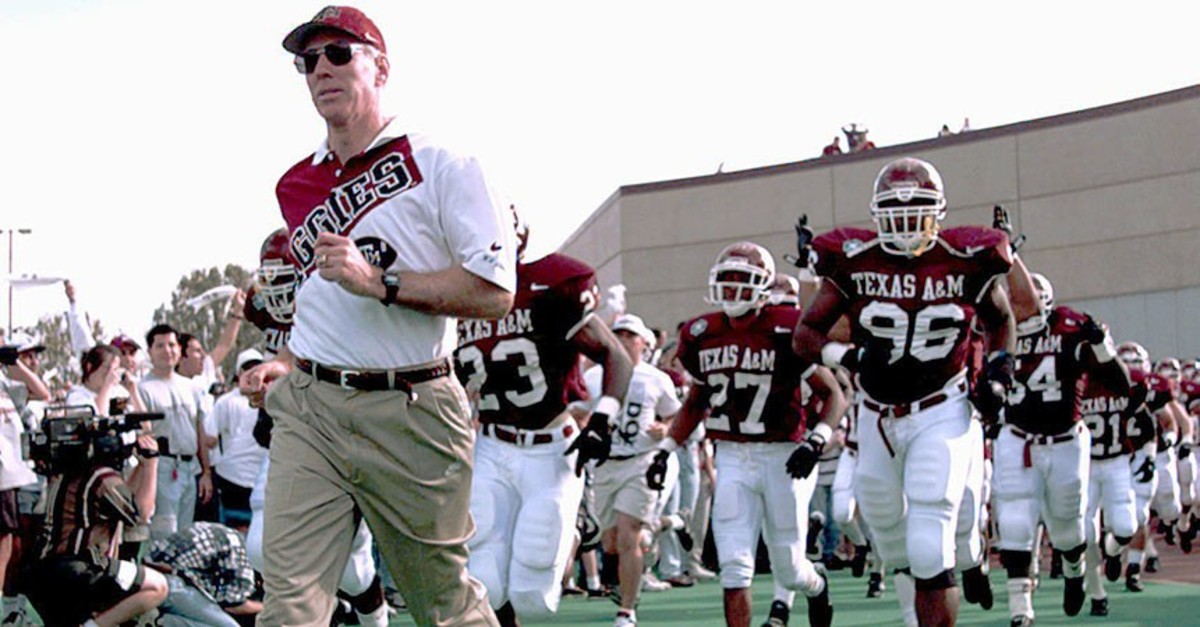
Photo: Eric Gay/AP
Slocum: We called a meeting [in 1990]: myself; [Texas A&M athletic director John David] Crow; Bill Mobley, who was A&M's president at the time; the chairman of the board of regents, Ross Margraves; and Billy Clayton, who [had been] the speaker of the Texas House. They said we don't want to be out there like we're involved with breaking up the league, but what we should do is see where we are.
Cunningham: A&M and Texas were locked at the hip. We had to work out something that was acceptable to both schools.
Slocum: I knew Roy Kramer, who was the commissioner of the SEC at the time. So I call Roy, and I say, "Roy, it sounds like this Southwest Conference might be coming apart. If it does, we were wondering would there be any interest in A&M in the Southeastern Conference?"
Cunningham: The SEC was seriously considered. I don't want to say that it was not. But it was never our top priority, and we never made a move to join the SEC.
In 1991 and '92, conversations among Texas, Texas A&M and Texas Tech led to several attempts at compromise, none of which appealed to the schools or the legislators who were by then involved. Could Texas head to the Pac-10 and Texas A&M to the SEC? No. Could Texas Tech and Texas both go west? No, the Pac-10 wasn't interested in the Red Raiders.
Meanwhile, members of the Big Eight faced their own set of concerns about television market size and the viability of their conference. Wefald was especially concerned, and at a 1990 National Association of Land Grant Schools meeting, he initiated a conversation between the Big Eight and SWC. As the chairman of the Association of Big Eight Universities, Wefald felt his title gave him the power bring up a potential merger, but he lacked clout due to Kansas State's subpar athletics.
Wefald: Geez, this guy from Kansas State trying to get all of us to join the Big Eight. They probably viewed me as kind of a humorous figure. In 1990, I don't think too many other ADs were really thinking of this kind of merger.
I think 11 of the 16 schools were there [at the meetings]. This was just for initial discussion. Here, it's on the table: Are there benefits to a merger? Instead of eight and eight, we'd be 16. The conversation went on for 30 minutes, and Bill Cunningham, I would say he had an attitude. He was a brilliant fellow, but I think he knew that too. So 30 minutes into the meeting, he says, "We are not interested."
Cunningham: If I acted a little hesitant, I was probably just trying to be careful and trying to understand what they were putting on the table. We were not interested in taking alternatives off the table at that stage. We were interested in learning what alternatives did exist. The Big Eight was not at that point a priority conference for us.
Wefald: Texas A&M and Texas, they can go wherever they want.
STAPLES: Ranking Big 12's best options for conference expansion
Walden: When we first heard things, we were hearing that we would all be joining some other conference. Iowa State might go in the Big Ten, and Nebraska would go somewhere else. I think we heard more about us leaving than we ever heard about [other teams joining].
Wefald: When the dominoes start falling, people panic. Even major schools, they start thinking, is this the conference I want to be in?
Bob Stull, Missouri coach from 1989–93: When I was [at Missouri], most of the talk was about going to the Big Ten. Everybody felt like we belonged, geographically and academically, with the Big Ten.
Walden: The Big Eight was such a vulnerable conference because of its size. [But] the athletic directors were shooting us straight. They said, "We will stay as a conference. It doesn't mean we won't add somebody, but we will not split this league, unless it's your choice to go."
Joe Castiglione, Missouri athletic director from 1993–98, Oklahoma athletic director from 1998-present: I don't ever remember having any feeling cross my mind of instability or being left behind. [The conference was] in the midst of celebrating a great run of success, and seeing the world outside us evolve, we were concerned that if we weren't proactive in addressing these opportunities, that we could find ourselves in a position where we weren't able to support the programs that we sponsored like we had been.
Dodds: It was a lot about television marketplace and our lack of it in the Southwest Conference. We had a lot of conversation internally about that on our staff, and then we reached out to Donnie Duncan, the AD at Oklahoma, because we saw the Big Eight in the same situation, not enough TV sets. Donnie was very open to talking about it. I think [the Big Eight was] pretty happy with [its] situation, and Donnie helped paint the picture of the future, and once everybody figured that out, it was evident that something had to be done.
Kansas State coach Bill Snyder, to reporters in August 1990: Everybody's looking for TV sets, and the last I heard, there are a bunch of them running around in the Dallas-Fort Worth area, and a whole bunch of them in Houston. They've got a few in Kansas City.
Castiglione: We even had a very good television deal for our conference and were comfortable with it as it stood for that period of time. Status quo wasn't going to be possible, and that's where we had concerns. It took a while to get everybody on board to understand that because we were in the midst of a great deal of success, and some people thought, why are we trying to do anything different?
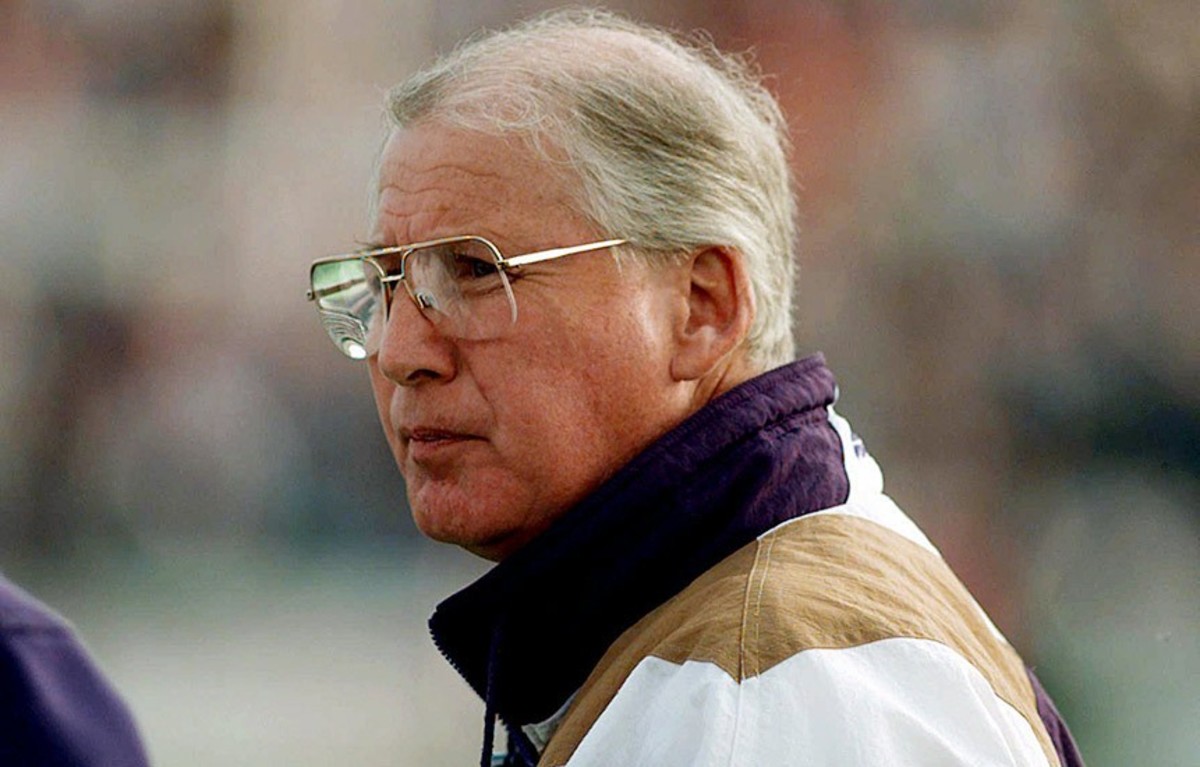
Photo: Cliff Schiappa/AP
Snyder, to reporters in August 1990: My idea is that we take the bottom half of the Southwest Conference, and the bottom half of the Big Eight Conference and we merge them. … We take ourselves, Kansas perhaps, maybe Oklahoma State, perhaps Missouri or Iowa State. Then we take the same group out of the Southwest Conference—TCU, SMU, maybe Houston, Rice, perhaps Texas Tech. We put them all together and we contract a bowl game.
Big Eight CEOs, in a statement on Sept. 27, 1990: We believe meaningful cooperation with the Southwest Conference has the potential for the mutual benefit of both conferences. With this in mind, we recommend that the presidents from the two conferences confer with the two conference commissioners on subjects of mutual interest: television, scheduling of contests, and other items of mutual interest.
Walden: If you're Iowa State during those years, you're like, man, I don't know if I need anymore of these [traditional powers]. And then when you hear rumors that you could conceivably be gaining Texas and Texas A&M, the thing that frightens you to death is you know they're going to be strong teams forever. It wasn't so much frightening so much as it was, hey, man, maybe they'll bring a couple of teams like Baylor that we can beat.
BECHT: 2016 Big 12 preview: Projected standings, top storylines, more
Throughout the early '90s, any talk of a Big Eight-SWC merger was just that: talk. Texas and Texas A&M had more attractive offers to explore, but as 1993 turned to '94, the merger began to look more appealing to the Longhorns, whose alternatives were dwindling. So on Feb. 11, 1994, the presidents of the 16 Big Eight and SWC schools and the commissioners of both leagues met at the Dallas-Ft. Worth Airport Hyatt to see if they could come to some kind of agreement to sell their television rights as a package.
By then, Cunningham had been promoted to chancellor of the University of Texas system, and Bob Berdahl had replaced him as president. Still, Cunningham kept a hand in realignment, never ceding the decision-making. At the meeting, the group called for a show of hands of those supporting a merger. As they went around the table, 15 presidents gestured in favor. Berdahl was the final hand, and he told the group that he'd have to take the decision to Texas's board of regents. Wefald remembers Berdahl's final comment: "If I had my way, we'd join the Pac-10."
Wefald: It was like the shootout at the O.K. Corral. Then everything cooled down, and we adjourned. Let's try to get a conference call at some point in the next 10 days or two weeks.
Dodds: What we wanted was to build a conference that had strength and durability and longevity. The pieces from the Big Eight and the pieces from the Southwest Conference as one just looked a whole lot better to everybody than any other option.
Cunningham: We were running out of alternatives.
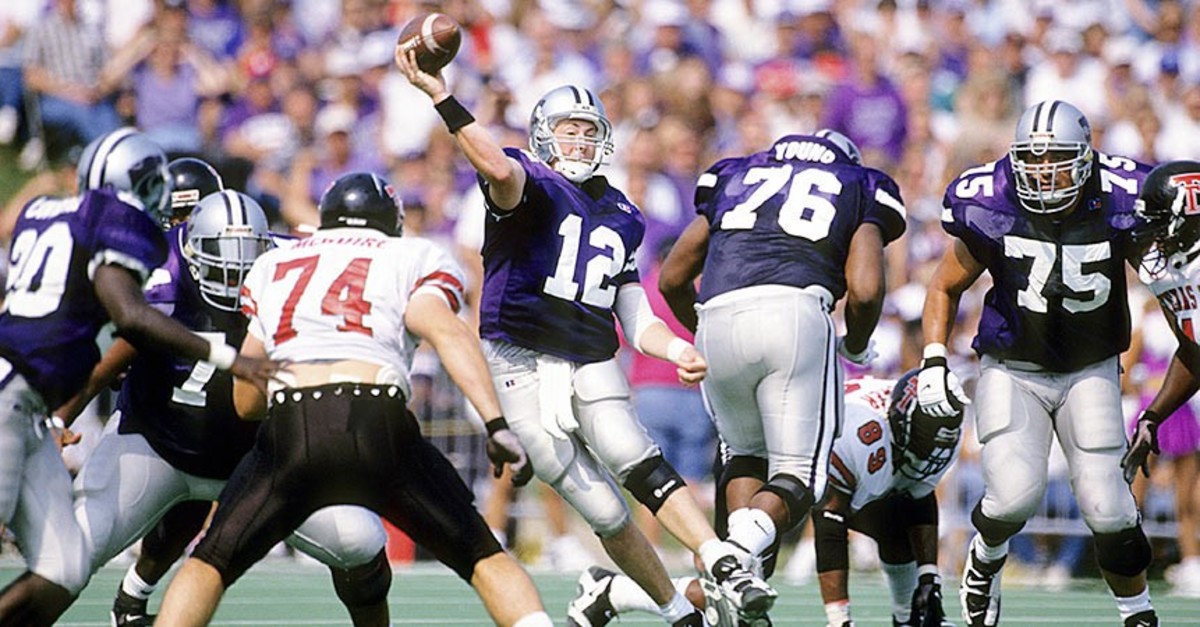
Photo: Damian Strohmeyer
Meanwhile, ABC/ESPN got involved.
Chuck Neinas, Big Eight commissioner from 1971–80, executive director of the CFA from 1980–97: ESPN did not want all the members. They wanted eight from the Big Eight and they'd take four from the Southwest Conference. Obviously, the two they wanted most were Texas and Texas A&M. I received a call from Loren Matthews, who was a key executive with ESPN with whom I had developed a good relationship. And Loren told me, he said, "Here's my problem. We want the Big Eight, but we don't want all of the Southwest Conference." I said, "Well, just let me make some phone calls, and I'm sure they'll get back to you." So I called DeLoss Dodds at Texas, Donnie Duncan at Oklahoma and Bill Byrne at Nebraska, and the rest is history.
With that, the issue became more political. Rumors still flew that Texas was headed to the Pac-10 and Texas A&M to the SEC. David Sibley, a Baylor graduate who was a Texas state senator from 1991–2000, wanted answers, and he and Rob Junell, then the chairman of the Texas House Appropriations Committee, decided to take action. They confirmed that Texas A&M still had interest in the SEC, but Texas's preference for the Big Eight and the looming ABC/ESPN compromise dictated the future of the SWC.
STAPLES: Could TV networks exercise "nuclear option" to halt Big 12 expansion?
Sibley:
We had a brief conversation, and it ended with Junell saying, "Cut loose the dogs of war." At the time, Bob Bullock was the lieutenant governor, and he was a Baylor Law graduate. The speaker of the house was from Texas Tech, and [Junell] was from Texas Tech. And then the chairman of the Senate Finance Committee was a Texas Tech person, John Montford. And then there I was, representing Waco and a Baylor graduate.
Junell and Sibley mobilized on Thursday or Friday, Sibley says, and by Sunday, a group was assembled in Bullock's office to strike a deal. The lieutenant governor, along with Sibley, Montford, Cunningham and Clayton (the former speaker of the Texas House of Representatives and an A&M graduate) agreed: in addition to Texas and Texas A&M, Texas Tech and Baylor would make the cut.
Sibley: The interesting part of this is that if this had happened two years earlier, the lieutenant governor would have been a University of Houston person and the speaker of the house would have been a TCU person. It really was an interesting confluence of events.
Castiglione: It was our impression that the four institutions from the Southwest Conference would be Texas, Texas A&M, Texas Tech and Houston.
Cunningham: A&M and Texas were easy, and Texas Tech had the third-best attendance. Then we came down to the fourth school, and that was Baylor versus TCU. When you really looked at the hard data, Baylor was the better choice. They had better attendance and better records. When I called the Baylor president, he was not in, and I spoke with his wife. His wife told me that he was at a prayer meeting, and I said, "I now believe in prayer more than ever."
Bob Bockrath, Texas Tech athletic director from 1993–96: There wasn't any question that to be one of those left out would have been a disaster.
Wefald: My heart really did go out to those other four, [Houston, TCU, SMU and Rice]. They're like us. They're smaller schools that didn't have the football tradition. That could have been us.
Cunningham: The (chancellor) of TCU, Bill Tucker, he's a class act, and he said, "Bill, I understand. However, we are going to compete at a level that will make you all want to have us at some time in the future." I said all the right things that you would say in a polite conversation, but I have to say I didn't believe it that they would perform at that level.
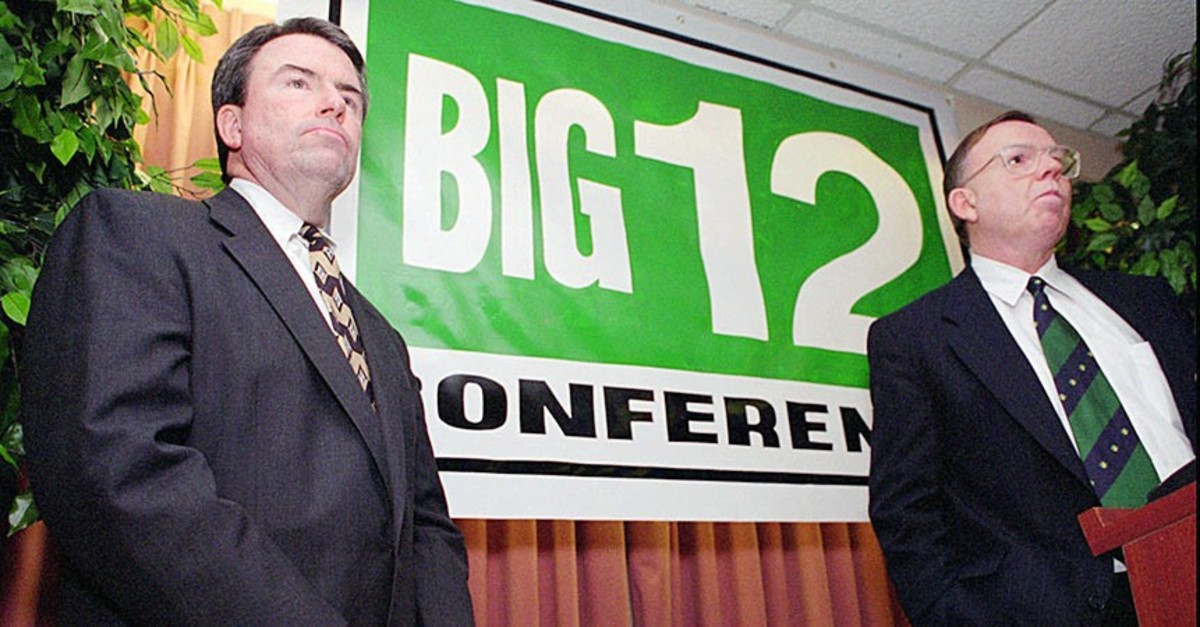
Photo: Tim Sharp/AP
On Feb. 25, 1994, the new conference was announced, with play to begin in the fall of 1996. The news was met with a certain amount of shock; the conference landscape would never be the same, and television rights were officially crowned king. "Look for Kazakhstan to join the ACC," NBC Sports vice president Ed Markey told USA Today on the day of the announcement. "And Belarus may be on the fence between the Southwest Conference and a football-only Big East deal."
After the excitement—and sarcasm—cooled, the work began.
Dodds: Truthfully, that may have been the most fun of everything we did, putting it together with the 12 ADs. There were meetings where I'd leave thinking, wow. Working together, compromising, making decisions that gave everybody a good feeling and more stability than they had in the past.
Wefald: If Texas is going to join the Big 12, there are certain things that have to be taken care of. Gate receipts; in the Southwest Conference, every school kept its own, where in the Big Eight, we distributed it 65–35. And then on television distribution, Texas recommended that 50% of TV revenue would be divided evenly, and the other 50% would go to appearances.
Slocum: I remember one meeting in particular, when they were talking about scheduling. We'd had the traditional game of A&M-Texas on Thanksgiving and the Nebraska-OU game that weekend. Some of the other coaches were saying, "You all say all of this is going to be done with a computer. How come is it that A&M and Texas and OU and Nebraska all still have their games?" Donnie Duncan said, "I'm going to be frank about it to you: The only inventory that we really have that the networks are really excited about and want is the A&M-Texas game and the OU-Nebraska game." I'm not sure if everybody appreciated that.
Bockrath: There [are] four things that stick out after all these years. One was the issue of revenue production and how that revenue would be shared. I think that was probably the most important issue. The second was where the conference headquarters were going to be. The third was who the commissioner was going to be, and the fourth one, oddly enough, was how were we going to blend records from two different conferences?
Wefald: I voted for everything Texas wanted. Whatever they wanted was fine with me.
It took more than a year for the conference to resolve these arguments, and the debate was portrayed in the press as acrimonious, with battle lines drawn at times between the old Big Eight and old SWC, other times between the haves and the have-nots and too often between Texas and Nebraska. In the end, the conference landed an eight-year football television contract with ABC, worth $95 million for regular-season games and $27.7 million for the annual championship game, and a five-year, $42.5 million deal with Fox Sports. The schools agreed to divide the television payouts for bowls and championship games equally; for regular-season television revenue, each school would receive $750,000 annually, plus $142,000 for every ABC appearance and $72,500 for every Fox Sports appearance. In addition, home teams would keep 100% of their gate receipts.
The league also determined that it would be headquartered in Dallas—a victory for Texas—and that Steve Hatchell, the former SWC commissioner, would hold the same title in the new league.
One issue, though, was especially divisive: the question of how many partial qualifiers, if any, would be allowed to compete. Nebraska for years had admitted these "Prop 48" athletes, who did not meet the NCAA's eligibility requirements; instead of attending junior college, they'd lose a year of eligibility but benefit from the school's academic support to get their scores up to par. In fact, on Nebraska's 1995 national championship team, four starters were Prop 48 players. However, the SWC had not allowed partial qualifiers, nor did Texas think the new league should. Eventually, the Big 12 ruled that it would allow two male and two female Prop 48 athletes per school per year, angering Nebraska.
Bockrath: That was the tug-of-war, [Texas and Nebraska], right there, and the rest of us were in the middle.
Wefald: At the University of Nebraska, they had at least 20 [Prop 48 players], if not more. And who were they? They were beasts.
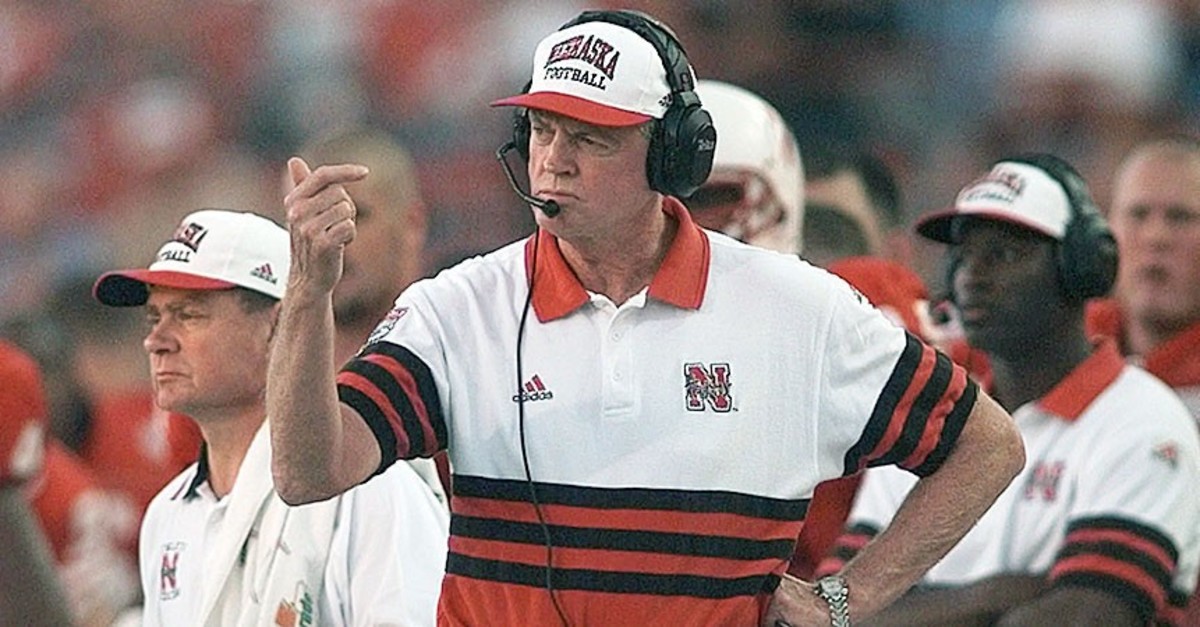
Photo: John Gaps III/AP
Slocum: Nebraska came in with a great program and a great history, and I think they were offended all along. Tom Osborne told me that at the time that they resented the way they were treated at some time in the conference. They were like a little stepchild from the north.
Walden: I won't say who [told me], but one of the major reasons why Nebraska left to go to the Big Ten [in 2010] was they were tired of Texas. That's just an opinion. Maybe 100 people will deny that, but that's what I surmise.
The early days of the league were not without growing pains. In the first year of the television contract, schools bristled when networks chose games based on television market size rather than performance. In addition, some worried that the two divisions made the state of Texas too insular. Still, the league that began as an uneasy truce blossomed into one of the most powerful conferences in college sports. With Nebraska anchoring the north and Texas the south, a sort of divisional parity did exist.
In the 20 years since the genesis of the Big 12, television deals have skyrocketed. For the 2015–16 fiscal year, each of the (now 10) Big 12 schools received $30.4 million in revenue disbursement, an increase of 20% over the previous period. The numbers are staggering, and they've pushed realignment to a frenzy over the past six years, which have seen the dismemberment of the Big East, the dissolution of Conference USA, expansion in the Pac-10, Big Ten and SEC, the formation of the American Athletic Conference and restructuring in the Big 12, among other changes. With this transformation has come uncertainty—and a measure of reflection by many of the men who helped create the conference two decades ago.
Walden: When the Southwest Conference busted and the major four came to the Big Eight, that was a forerunner of thinking, hmm, maybe we could do this. It was like somebody finally saw [realignment for financial concerns] could happen. We'd had all these conferences for all these years with all these teams, and there was always only a little bit of movement.
Neinas: I guess you could say that this probably was the first time that a conference had joined together for the benefit of a media contract, and now you see conferences expanding and reconfiguration, and a lot of it is done for the [explicit] purpose of generating more TV revenue.
STAFF: 10 players to watch in the Big 12 in 2016
Walden: The Big 12 never became as harmonious as the old Big Eight, and that was hard on the old Big Eight people.
Sibley: It was like a divorce or old friends dying. I thought it was a horrible time. It was a heartbreaking time. It was bittersweet, bittersweet. You're breaking up [families].
Wefald, in his book, The Transformative Years at K-State: If I could have waved a magic wand, the Big 8 ([sic] Conference would have lasted forever.
Sibley: It's just the way fortune fell.
